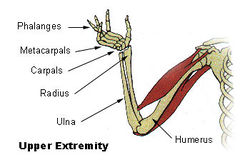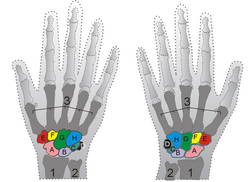Radius (bone)
| Bone: Radius (joint) | |
|---|---|
 |
|
| Upper extremity | |
 |
|
| Radius is #1 | |
| Gray's | subject #52 219 |
| MeSH | Radius |
The radius is the bone of the forearm that extends from the lateral side of the elbow to the thumb side of the wrist. The radius is situated on the lateral side of the ulna, which exceeds it in length and size. It is a long bone, prism-shaped and slightly curved longitudinally. The radius articulates with the capitulum of the humerus.
The word radius is Latin for "ray". In the context of the radius bone, a ray can be thought of rotating around an axis line extending diagonally from center of capitulum to the center of distal ulna. The purpose of the radius is to connect the elbow to the forearm.[1]
Contents |
Shape
The radius has a body and two extremities. The upper extremity of the radius consists of a somewhat cylindrical head articulating with the humerus, a neck, and a single tuberosity. The body of the radius is self-explanatory, and the lower extremity of the radius is roughly quadrilateral in shape, with articular surfaces for the ulna, scaphoid and lunate bones
Muscle attachments
The biceps muscle attaches to the tuberosity of the upper extremity of the bone. The upper third of the body of the bone attaches to the supinator, the flexor digitorum superficialis, and the flexor pollicis longus muscles. The middle third of the body attaches to the extensor ossis metacarpi pollicis, extensor primi internodii pollicis, and the pronator teres muscles. The lower quarter of the body attaches to the pronator quadratus muscle and the tendon of the supinator longus.
Structure
The long narrow medullary cavity is enclosed in a strong wall of compact bone. It is thickest along the interosseous border and thinnest at the extremities, save over the cup-shaped articular surface (fovea) of the head.
The trabeculae of the spongy tissue are somewhat arched at the upper end and pass upward from the compact layer of the shaft to the fovea capituli (the humerus's cup-shaped articulatory notch); they are crossed by others parallel to the surface of the fovea. The arrangement at the lower end is somewhat similar. It is missing in radial aplasia.
In other animals
In four-legged animals, the radius is the main load-bearing bone of the lower forelimb. Its structure is similar in most terrestrial tetrapods, but it may be fused with the ulna in some mammals (such as horses) and reduced or modified in animals with flippers or vestigial forelimbs.[2]
Gallery
|
Radius l. dx. - ant. view |
Radius l. dx. - post. view |
Right human radius and ulna - post. view |
 Human arm bones diagram |
 Bones of left forearm - ant. view |
 Bones of left forearm - post. view |
 Left elbow-joint, showing anterior and ulnar collateral ligaments |
 The Supinator |
|
Cross-section through middle of forearm |
 Transverse section across distal ends of radius and ulna |
See also
- Bone terminology
- Terms for anatomical location
- Ossification of radius
References
- ↑ http://boneandspine.com/
- ↑ Romer, Alfred Sherwood; Parsons, Thomas S. (1977). The Vertebrate Body. Philadelphia, PA: Holt-Saunders International. p. 199. ISBN 0-03-910284-X.
External links
This article was originally based on an entry from a public domain edition of Gray's Anatomy. As such, some of the information contained within it may be outdated.
|
||||||||||||||||||||||
| This musculoskeletal system article is a stub. You can help Wikipedia by expanding it. |